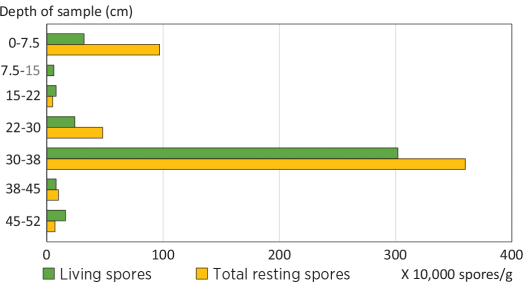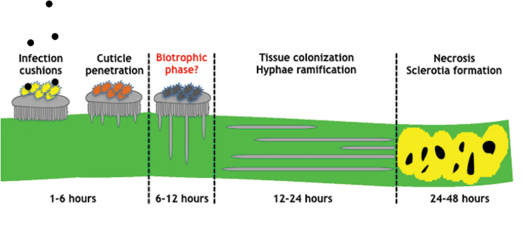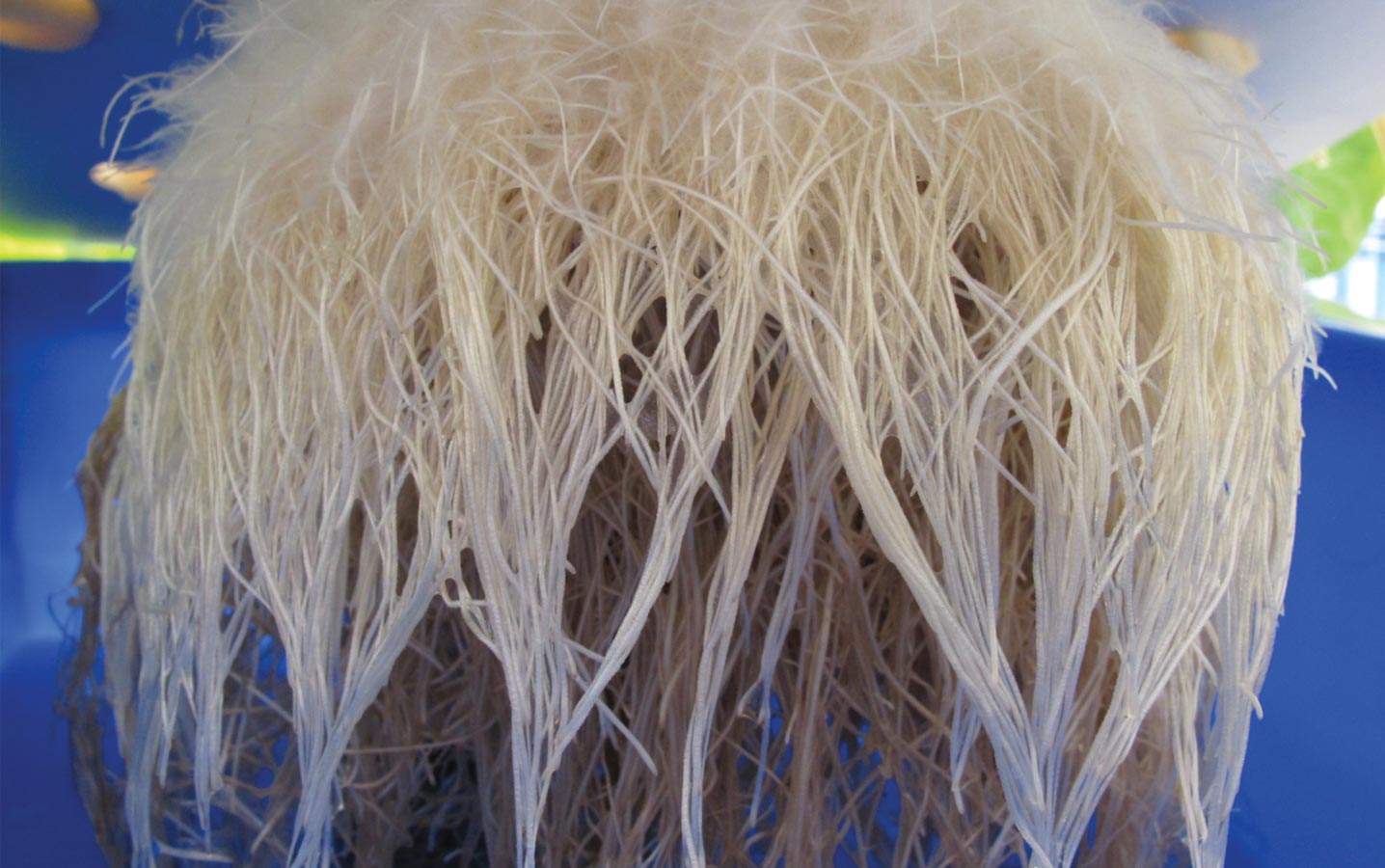Sclerotinia infection moves faster than we thought
Canola Discovery Forum 2017 was part of Canola Week, which attracted 375 attendees in Saskatoon in December. Discovery Forum featured sessions on sclerotinia stem rot, clubroot, blackleg fertilizer and a panel on “adapting to change”. Here are a few notable discoveries.
Sclerotinia stem rot timeline for infection
Dwayne Hegedus, research scientist at Agriculture and Agri-Food Canada (AAFC) Saskatoon, presented on the sclerotinia stem rot infection cycle. It begins when sclerotia in the soil (left from the last time an infected crop was produced on that field) take up enough moisture to germinate and form little mushrooms known as apothecia. Spores are then released into the air from the mushrooms. Under ideal warm and moist conditions, it takes about two to three weeks for sclerotia to germinate and release spores.
Once spores are released, some land on flower petals and some of those petals fall on stems and leaves. Spores then germinate and the fungus grows on the dead petals for a short time before coming into direct contact with the plant. At this point, the infection proceeds very quickly with lesions being visible in as little as 24 hours.
Hegedus describes the steps:
- The waxy outer surface of the plant, the cuticle, is penetrated within hours. “This is much quicker than we thought it would be,” Hegedus says. In as little as one hour of the fungus being placed on a healthy plant, genes for the enzymes that break down the cuticle and for toxins that kill the plant were already being expressed, he says.
- Once the cuticle has been penetrated, the fungus grows within the plant tissue in a kind of stealth mode for a short, but critical, period that lasts six to 12 hours. “In this ‘biotrophic phase’, the pathogen is essentially hiding from the plant, allowing it to quickly build up biomass before radiating through plant tissues,” Hegedus says. This is an important stage for research, he says, because if they could target that phase with an improved genetic response from the plant, they could stop the spread that allows the disease to take hold.
- The fungus then rapidly colonizes the plant as hyphae begin to spread throughout the plant over the next 12 to 24 hours. Generous amounts of acid, digestive enzymes and toxins are being produced by the fungus during this phase.
- After just one day, the first visual symptoms of plant tissue death (necrosis) appear.
While researchers will continue to work to extend this knowledge and improve plant defenses from a genetic perspective, Hegedus says this information can assist farmers to make better decisions if they wish to “move away from prophylactic fungicide applications.”
He says the study stresses the importance of surveillance of fields for sclerotia and apothecia and the development of forecasting tools, since little can be done to save the plant once it has become infected. Fungicide applications now are based on pre-emptive prophylactic protection based on an assessment of the likelihood of infection. If farmers could instead scout for the first appearance of apothecia, they would know that spores will be present and infection will likely occur within a day or two if the crop is dropping petals and the canopy has the humid conditions necessary for infection.
Number of resting spores in soil at different depths – Alberta site

Clubroot spores: Living or dead?
The overall message from Mary Ruth McDonald, researcher and prof at the University of Guelph, is to keep clubroot spore counts low. This will limit economic damage from the disease. (For more on spore management tips, read Dan Orchard’s “5 steps to better…”)
Two messages from McDonald on clubroot spores:
Soil tests for the presence of clubroot DNA identify living and dead spores. An alternative test, which uses propidium monoazide (PMA), can separate the living from the dead. PMA binds to DNA and prevents amplification, but PMA cannot pass through the cell membrane of living cells. “At this time, commercial labs have not set up to use the PMA-PCR method, but we are talking to some of the provincial labs about implementing this approach. The method has been published in the scientific literature, so any lab could add it to their offerings,” McDonald says.
Clubroot spores can settle down in the soil profile at fairly high levels. McDonald shows clubroot spores at various depths for one field studied in Alberta. In that field, which had clubroot for at least 10 years, most of the spores were down at a depth of 30 to 38cm. Resting spores do move down in soil, probably washed down with water, she says, and in this field were probably held up by a compaction layer or hardpan around that 30 to 38cm depth. Instead of thinking that the spores live longer at depth, we think it is related to time. “It appears that ‘fresh’ or ‘young’ spores either have a large number that are immature and can’t germinate or that a relatively high proportion die off quickly, perhaps due to more extreme temperature and moisture variation at the soil surface,” she says. “The resting spores deeper in the soil will be older and the ones that survive for the first few years after they are produced seem to then go on to live for a long time.”
We might assume that deeper spores are not much of a yield threat to canola, but McDonald emphasizes that we don’t know for sure. “Very few researchers have looked at the distribution of resting spores in the soil profile, and no one has looked at how resting spores at depth actually affect canola growth.”
Blackleg: More complex than originally thought
Researchers are discovering how interactions between blackleg races in the field and varieties is more complex than originally thought. “While researchers work through the management implications for this complexity, for farmers, this shows the importance of an integrated management approach for the disease,” says Justine Cornelsen, agronomy specialist for the Canola Council of Canada. “The identification of major resistance genes within varieties will provide producers with another option, but it needs to be stewarded carefully with other best management practices for the disease.”
Dilantha Fernando at the University of Manitoba has been working on identifying the genes found across the canola growing regions of Canada to better understand gene interactions and how to properly rotate resistant varieties. Hossein Borhan, AAFC Saskatoon, has been identifying the complex gene interactions while working on developing new sources of resistance and developing an isolate set to screen for blackleg races within the field.
“This work will help identify new sources of resistance to be deployed across Canada,” Cornelsen says. “And understanding the fungus at the field level will help steward the new major-resistance gene label program that will help producers make informed variety decisions.”
The Infection Process

Fertilizer: Nitrogen ‘intensity optimum’
Reynald Lemke, research scientist with AAFC in Saskatoon, talked about managing nitrogen fertilizer in a carbon-concerned world. Nitrous oxide, the gassed-off loss from nitrogen applications, is a greenhouse gas and is one kilogram of nitrous oxide is the GHG equivalent of around 300 kg of CO2. These losses are also a waste of input dollars. Lemke went over the agronomic optimum, economic optimum and introduced a new idea called the “intensity optimum.”
Agronomic optimum is the rate of N fertilizer that produces the maximum grain yield.
Economic optimum is acceptable return on investment for the last pound of N applied. This will vary by crop and input prices and the grower’s own acceptable ratio for return on investment for the last pound of N applied. Some farmers are OK with a 1:1 ratio of return: cost for the last pound. Others want a higher ratio of return. Either way, the economic optimum will represent a lower N rate than the agronomic optimum.
Intensity optimum factors in the potential environmental cost (through N losses to the atmosphere or environment) of choosing a fertilizer N rate. For every increment of fertilizer N applied there is a risk of a negative environmental consequence (environmental cost).
“Because we’re not going to stop producing food, and we need fertilizer N to produce that food, then the appropriate response to this issue is to think in terms of intensity,” Lemke says. “Yields tend to increase strongly to the first increments of N applied and then increases begin to diminish at higher N rates, while environmental costs tend to increase slowly over the first increments of N and then increase strongly at the higher N rates.”
“This is not yet well established, but fertilizer N rate providing ‘optimum intensity’ is almost certainly going to be lower than the optimal agronomic rate, and probably close to but perhaps also a bit lower than the optimal economic rate,” he says.
Yield and economics of various rotations
Breanne Tidemann, research scientist with AAFC in Lacombe, presented during the “adapting to change” panel on a nine-year rotation study that compared continuous Liberty Link canola, continuous Roundup Ready canola, canola in a two-year rotation with wheat and canola in a three-year rotation with peas and barley. Trials were repeated at five locations across the Prairies and “all phases” were repeated each year. For example, for the canola-barley-peas rotation, every phase of the rotation – canola, peas and barley – were grown each year to eliminate the confounding effect of different environmental conditions each year.
When all sites and years are averaged, canola yield improved 5 bu./ac. with a one-year break and another 5 bu./ac. with a two-year break. While this is an average, Tidemann notes that results were quite different year to year and site to site. In Melfort, Sask., for example, there was no yield difference between rotations in 2012, but in 2016, canola yields were 17 bu./ac. higher with a one-year break and 34 bu./ac. higher with a two-year break.
When adding economic analysis to this study, net returns for each site each year were highly variable. “But when averaged across all sites and years, net returns were similar for all rotations,” Tidemann says.
A concluding document for the study had this statement: “These data refute the notion of continuous canola being the most profitable rotation. Furthermore, these data do not account for increased disease, insect pest and weed threats [from continuous canola] that are likely to threaten sustainable canola cropping over the long term.”
Canola helps the atmosphere
Brian McConkey, research scientist at AAFC Swift Current, presented during the “adapting to change” panel. He says Canadian soil organic carbon has been going up since 1971, which is a good thing for reducing carbon in the atmosphere, and canola leads the way. Seventy per cent of the increase in soil organic carbon in Canada since 2005 is due to canola alone, McConkey says. How? For one thing, canola has displaced almost all the summerfallow acres in that time, and summerfallow tends to release carbon, not store it. Another benefit is that canola will increase soil organic carbon more than cereals will. A big part of that is from the part of the plant we don’t see: the root. Canola root mass is huge compared to a cereal root, and that big root is effective for soil carbon sequestration. (See Leon Kochian’s root photo.)
Another positive factor: Canola crops are much more reflective than cereals. Yellow flowers reflect sunlight energy back out into space, and they do this during the hottest months of the year. This has a large cooling effect, McConkey says. Leaving stubble to catch snow also reflects more solar energy back into space, enhancing the global cooling effect.
Leon Kochian, associate director and research chair with the Global Institute for Food Security in Saskatoon, grew these canola roots hydroponically. He doesn’t think any crop plant could do this in the field, but it gives you an idea of the potential root biomass of a canola plant. This is how canola can sequester large amounts of carbon.





